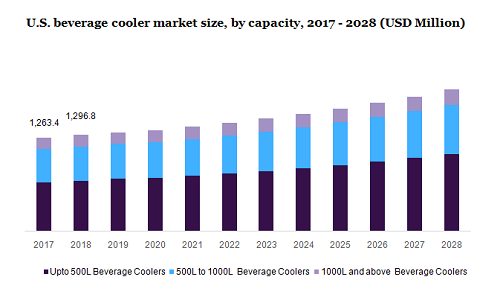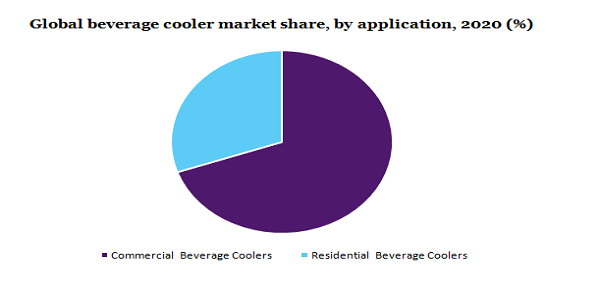- US: +1-408-610-2300
- Toll Free: +1-866-831-4085
- Become a Client
Report Overview
The global beverage cooler market size was valued at USD 5.8 billion in 2020 and is expected to expand at a compound annual growth rate (CAGR) of 5.0% from 2021 to 2028. Increasing demand for chilled beverages from both residential and commercial sectors is anticipated to propel the product’s demand. Continuous population growth, rapid urbanization, and increasing disposable income are among the significant factors, which are expected to positively influence the demand for beverage coolers globally. The rising popularity of alcoholic drinks in countries such as the U.S., The U.K., India, and Germany, especially among young consumers, is projected to further fuel the demand for chilled drinks, and thus, in turn, expand the market for these coolers.

In the U.S., the market is anticipated to witness substantial growth owing to the increasing consumption of alcoholic drinks such as wine and beer. Also, the increased availability of varieties of nutrition drinks coupled with the growing health awareness amongst consumers in the U.S is encouraging people to have drinks at their homes rather than in restaurants, and pubs. Further, the consumers are investing largely in specialized appliances such as coolers so as to retain the flavor and quality of specific beverages for an extended period. This trend is further expected to drive the market for beverage coolers in the U.S.
In the Asia Pacific, the market is projected to witness considerable growth in the upcoming years, owing to rising popularity among Millennials in developing economies including China and India. Rising consumption of alcoholic beverages such as wine and beer as compared to their other counterparts is propelled the demand for beverage coolers over the forecast period. Moreover, the growing awareness regarding the protection of drinks from harmful bacteria at room temperature is expected to fuel demand for temperature-controlled storage products, such as beverage coolers. Also, the manufacturers are focusing on introducing advanced technologies to maintain the taste and shelf life of beverages. All these factors are expected to expand market growth in the coming years.
The up-to 500L segment contributed to the highest revenue share of more than 49.0% in 2020 and is expected to escalate at the highest CAGR over the forecast period. Growing demand for up to 500L beverage coolers from developing nations such as China, India, and Brazil for commercial and residential applications is anticipated to drive the segment in the next few years.
Vendors in the market for beverage coolers are continuously launching new products with wider features in this category to provide a bigger storage area. Improved scalability, high efficiency, and reliable performance are among the key factors sustaining the segment’s competitiveness in the market.
The commercial application segment dominated the market and contributed to the highest revenue share of more than 69.0% in 2020 and is projected to register a substantial growth rate over the forecast period. Increasing consumption of cooled beverages around the world is propelling the demand for beverage coolers in the commercial segment. Moreover, rising product demand owing to the growing popularity of various types of beverages such as beer, wine, and nonalcoholic served at pubs, restaurants, and bars among millennials is expected to drive the segment.

The residential beverage cooler segment is projected to witness the highest CAGR of 6.4% during the forecast period. Different households have different demands when it comes to the capacity of beverage coolers. Most consumers prefer beverage coolers with maximum capacity owing to space constraints.
Changing consumer preferences, accessibility to a wide range of flavors, and rising disposable income of the consumers are some of the factors expected to positively impact the demand for beverage coolers on a global level. For instance, millennials prefer beer and other types of alcohol, which is expected to drive the market in the region. Further, the rise in demand for carbonated drinks among millennials is also expected to significantly contribute to market growth over the forecast period.
North America dominated the beverage cooler market and accounted for a significant market share of 29.0% in 2020, with the U.S. occupying a dominant revenue contributor position across the region. High demand for refrigerated non-alcoholic and alcoholic beverages along with a high density of convenience stores are the major factors driving the demand for beverage coolers in the region.
In the Asia Pacific, the market is projected to experience the fastest CAGR of 5.8% over the forecast period, with China being the major revenue contributor to the regional market growth. Increasing population in the region coupled with growing urbanization in countries such as China and India is likely to be the key catalyst for the growth in the demand for beverage coolers over the predicted timeline. Moreover, the expansion of the economy in the region also contributed to increasing disposable income, which became a key factor driving the market in the region. Moreover, the robust expansion of electronics stores in the countries such as China, India, and Japan provided the vendors of the market with a key distribution channel to penetrate the rural and urban regions.
Industry participants are practicing several inorganic and organic growth strategic initiatives in order to expand their product/service portfolio and enhance their foothold across the market. In 2018, Haier Inc. signed an MoU with The Government of Uttar Pradesh, India, to build its second industrial park in India. With this investment, the company aims to scale up its production capacity of various products such as refrigerators (beverage coolers), air conditioners, washing machines, and LED panels.
Increasing competition at the regional and global levels is leading the market towards consolidation. The key companies are investing in smart technologies to increase their productivity. Also, global players are establishing manufacturing and distribution networks in developing countries to gain a market presence. Some of the prominent players in the beverage cooler market include:
• Whirlpool
• Haier Inc.
• AB Electrolux
• Danby
• LG Electronics
• Perlick Corporation
• Shenzhen VRBON Electrical Appliance Co.
• Allavino
|
Report Attribute |
Details |
|
The market size value in 2021 |
USD 6.0 billion |
|
The revenue forecast in 2028 |
USD 8.6 billion |
|
Growth Rate |
CAGR of 5.0% from 2021 to 2028 |
|
The base year for estimation |
2020 |
|
Historical data |
2017 - 2019 |
|
Forecast period |
2021 - 2028 |
|
Quantitative units |
Revenue in USD million and CAGR from 2021 to 2028 |
|
Report coverage |
Revenue forecast, company ranking, competitive landscape, growth factors, and trends |
|
Segments covered |
Capacity, application, region |
|
Regional scope |
North America; Europe; Asia Pacific; Central & South America; Middle East & Africa |
|
Country scope |
U.S.; U.K.; Germany; China; Japan; India; Brazil; South Africa |
|
Key companies profiled |
Whirlpool.; Haier Inc.; AB Electrolux; Avallon; Danby; The Middleby Corporation; LG Electronics; Perlick Corporation; Shenzhen VRBON Electrical Appliance Co.; Allavino |
|
Customization scope |
Free report customization (equivalent up to 8 analysts working days) with purchase. Addition or alteration to country, regional & segment scope. |
|
Pricing and purchase options |
Avail of customized purchase options to meet your exact research needs. Explore purchase options |
This report forecasts revenue growth at global, regional, and country levels and provides an analysis of the latest industry trends in each of the sub-segments from 2017 to 2028. For the purpose of this study, Grand View Research has segmented the global beverage cooler market report on the basis of capacity, application, and region:
• Capacity Outlook (Revenue, USD Million, 2017 - 2028)
• Up-to 500L
• 500L to 1000L
• 1000L and above
• Application Outlook (Revenue, USD Million, 2017 - 2028)
• Commercial
• Residential
• Regional Outlook (Revenue, USD Million, 2017 - 2028)
• North America
• U.S.
• Europe
• U.K.
• Germany
• The Asia Pacific
• China
• Japan
• India
• Central & South America
• Brazil
• Middle East & Africa
• South Africa


Research Support Specialist, USA